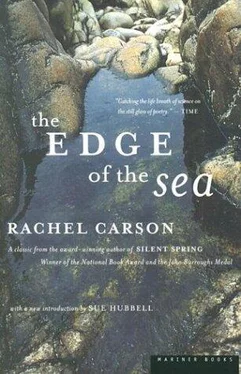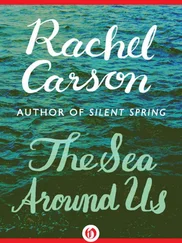Rachel Carson - The Edge of the Sea
Здесь есть возможность читать онлайн «Rachel Carson - The Edge of the Sea» весь текст электронной книги совершенно бесплатно (целиком полную версию без сокращений). В некоторых случаях можно слушать аудио, скачать через торрент в формате fb2 и присутствует краткое содержание. Город: Boston, Год выпуска: 1998, ISBN: 1998, Издательство: Mariner Books, Жанр: Биология, sci_ecology, sci_popular, на английском языке. Описание произведения, (предисловие) а так же отзывы посетителей доступны на портале библиотеки ЛибКат.
- Название:The Edge of the Sea
- Автор:
- Издательство:Mariner Books
- Жанр:
- Год:1998
- Город:Boston
- ISBN:978-0-395-07505-0
- Рейтинг книги:4 / 5. Голосов: 1
-
Избранное:Добавить в избранное
- Отзывы:
-
Ваша оценка:
- 80
- 1
- 2
- 3
- 4
- 5
The Edge of the Sea: краткое содержание, описание и аннотация
Предлагаем к чтению аннотацию, описание, краткое содержание или предисловие (зависит от того, что написал сам автор книги «The Edge of the Sea»). Если вы не нашли необходимую информацию о книге — напишите в комментариях, мы постараемся отыскать её.
A book to be read for pleasure as well as a practical identification guide,
introduces a world of teeming life where the sea meets the land. A new generation of readers is discovering why Rachel Carson’s books have become cornerstones of the environmental and conservation movements. New introduction by Sue Hubbell.
The Edge of the Sea — читать онлайн бесплатно полную книгу (весь текст) целиком
Ниже представлен текст книги, разбитый по страницам. Система сохранения места последней прочитанной страницы, позволяет с удобством читать онлайн бесплатно книгу «The Edge of the Sea», без необходимости каждый раз заново искать на чём Вы остановились. Поставьте закладку, и сможете в любой момент перейти на страницу, на которой закончили чтение.
Интервал:
Закладка:
The records of paleontology provide evidence of the changing shapes of continents and the changing flow of the ocean currents, for these earlier earth patterns account for the otherwise mysterious present distribution of many plants and animals. Once, for example, the West Indian region of the Atlantic was in direct communication, via sea currents, with the distant waters of the Pacific and Indian Oceans. Then a land bridge built up between the Americas, the Equatorial Current turned back on itself to the east, and a barrier to the dispersal of sea creatures was erected. But in species living today we find indications of how it was in the past. Once I discovered a curious little mollusk living in a meadow of turtle grass on the floor of a quiet bay among Florida’s Ten Thousand Islands. It was the same bright green as the grass, and its little body was much too large for its thin shell, out of which it bulged. It was one of the scaphanders, and its nearest living relatives are inhabitants of the Indian Ocean. And on the beaches of the Carolinas I have found rocklike masses of calcareous tubes, secreted by colonies of a dark-bodied little worm. It is almost unknown in the Atlantic; again its relatives are Pacific and Indian Ocean forms.
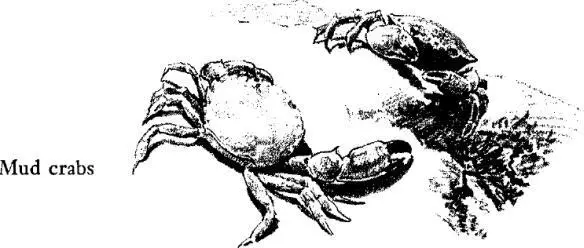
And so transport and wide dispersal are a continuing, universal process—an expression of the need of life to reach out and occupy all habitable parts of the earth. In any age the pattern is set by the shape of the continents and the flow of the currents; but it is never final, never completed.
On a shore where tidal action is strong and the range of the tide is great, one is aware of the ebb and flow of water with a daily, hourly awareness. Each recurrent high tide is a dramatic enactment of the advance of the sea against the continents, pressing up to the very threshold of the land, while the ebbs expose to view a strange and unfamiliar world. Perhaps it is a broad mud flat where curious holes, mounds, or tracks give evidence of a hidden life alien to the land; or perhaps it is a meadow of rockweeds lying prostrate and sodden now that the sea has left them, spreading a protective cloak over all the animal life beneath them. Even more directly the tides address the sense of hearing, speaking a language of their own distinct from the voice of the surf. The sound of a rising tide is heard most clearly on shores removed from the swell of the open ocean. In the stillness of night the strong waveless surge of a rising tide creates a confused tumult of water sounds—swashings and swirlings and a continuous slapping against the rocky rim of the land. Sometimes there are undertones of murmurings and whisperings; then suddenly all lesser sounds are obliterated by a torrential inpouring of water.
On such a shore the tides shape the nature and behavior of life. Their rise and fall give every creature that lives between the high- and low-water lines a twice-daily experience of land life. For those that live near the low-tide line the exposure to sun and air is brief; for those higher on the shore the interval in an alien environment is more prolonged and demands greater powers of endurance. But in all the intertidal area the pulse of life is adjusted to the rhythm of the tides. In a world that belongs alternately to sea and land, marine animals, breathing oxygen dissolved in sea water, must find ways of keeping moist; the few air breathers who have crossed the high-tide line from the land must protect themselves from drowning in the flood tide by bringing with them their own supply of oxygen. When the tide is low there is little or no food for most intertidal animals, and indeed the essential processes of life usually have to be carried on while water covers the shore. The tidal rhythm is therefore reflected in a biological rhythm of alternating activity and quiescence.
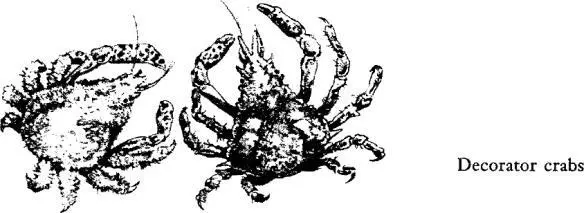
On a rising tide, animals that live deep in sand come to the surface, or thrust up the long breathing tubes or siphons, or begin to pump water through their burrows. Animals fixed to rocks open their shells or reach out tentacles to feed. Predators and grazers move about actively. When the water ebbs away the sand dwellers withdraw into the deep wet layers; the rock fauna brings into use all its varied means for avoiding desiccation. Worms that build calcareous tubes draw back into them, sealing the entrance with a modified gill filament that fits like a cork in a bottle. Barnacles close their shells, holding the moisture around their gills. Snails draw back into their shells, closing the doorlike operculum to shut out the air and keep some of the sea’s wetness within. Scuds and beach fleas hide under rocks or weeds, waiting for the incoming tide to release them.
All through the lunar month, as the moon waxes and wanes, so the moon-drawn tides increase or decline in strength and the lines of high and low water shift from day to day. After the full moon, and again after the new moon, the forces acting on the sea to produce the tide are stronger than at any other time during the month. This is because the sun and moon then are directly in line with the earth and their attractive forces are added together. For complex astronomical reasons, the greatest tidal effect is exerted over a period of several days immediately after the full and the new moon, rather than at a time precisely coinciding with these lunar phases. During these periods the flood tides rise higher and the ebb tides fall lower than at any other time. These are called the “spring tides” from the Saxon “sprungen.” The word refers not to a season, but to the brimming fullness of the water causing it to “spring” in the sense of a strong, active movement. No one who has watched a new-moon tide pressing against a rocky cliff will doubt the appropriateness of the term. In its quarter phases, the moon exerts its attraction at right angles to the pull of the sun so the two forces interfere with each other and the tidal movements are slack. Then the water neither rises as high nor falls as low as on the spring tides. These sluggish tides are called the “neaps”—a word that goes back to old Scandinavian roots meaning “barely touching” or “hardly enough.”
On the Atlantic coast of North America the tides move in the so-called semidiurnal rhythm, with two high and two low waters in each tidal day of about 24 hours and 50 minutes. Each low tide follows the previous low by about 12 hours and 25 minutes, although slight local variations are possible. A like interval, of course, separates the high tides.
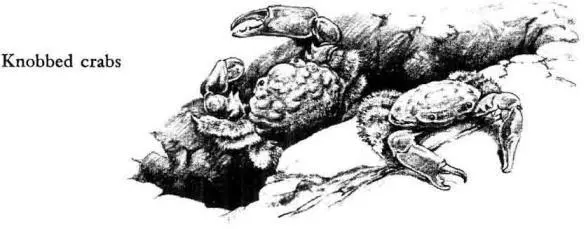
The range of tide shows enormous differences over the earth as a whole and even on the Atlantic coast of the United States there are important variations. There is a rise and fall of only a foot or two around the Florida Keys. On the long Atlantic coast of Florida the spring tides have a range of 3 to 4 feet, but a little to the north, among the Sea Islands of Georgia, these tides have an 8-foot rise. Then in the Carolinas and northward to New England they move less strongly, with spring tides of 6 feet at Charleston, South Carolina, 3 feet at Beaufort, North Carolina, and 5 feet at Cape May, New Jersey. Nantucket Island has little tide, but on the shores of Cape Cod Bay, less than 30 miles away, the spring tide range is 10 to 11 feet. Most of the rocky coast of New England falls within the zone of the great tides of the Bay of Fundy. From Cape Cod to Passamaquoddy Bay the amplitude of their range varies but is always considerable: 10 feet at Provincetown, 12 at Bar Harbor, 20 at Eastport, 22 at Calais. The conjunction of strong tides and a rocky shore, where much of the life is exposed, creates in this area a beautiful demonstration of the power of the tides over living things.
Читать дальшеИнтервал:
Закладка:
Похожие книги на «The Edge of the Sea»
Представляем Вашему вниманию похожие книги на «The Edge of the Sea» списком для выбора. Мы отобрали схожую по названию и смыслу литературу в надежде предоставить читателям больше вариантов отыскать новые, интересные, ещё непрочитанные произведения.
Обсуждение, отзывы о книге «The Edge of the Sea» и просто собственные мнения читателей. Оставьте ваши комментарии, напишите, что Вы думаете о произведении, его смысле или главных героях. Укажите что конкретно понравилось, а что нет, и почему Вы так считаете.
